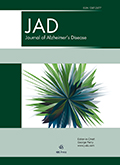Authors: Guo, Jian-Ping | Yu, Sheng | McGeer, Patrick L.
Article Type:
Research Article
Abstract:
Compounds that will inhibit buildup of amyloid-β(Aβ) deposits in Alzheimer's disease (AD) brain are potential therapeutic agents. Here we report the development of two simple in vitro screening assays to identify such agents. We use these assays to evaluate the relative potency of some possible candidates. One assay is based on binding of fluorescence-tagged Aβ1–42 to synthetic Aβ1–42 plated in wells of fluorescent black-wall microplates. Fluorescence-tagged Aβ1–42 solutions with and without blockers are then added to the plates, and the amount of bound fluorescence is measured. Another is a tissue type assay, where sections of unfixed AD
…or AD model transgenic mouse brains are mounted on glass slides. The same solutions assayed in the microplate test are then added to tissue sections. Binding of fluorescence-tagged Aβ1–42 to the Aβ deposits in AD or transgenic brain tissue is detected with a fluorescence microscope. Good agreement is obtained between the two methods. Most of the tested agents have too low an affinity for Aβ1–42 to be effective clinically. Agents that may have marginal affinity according to these tests include 1,2,3,4,6-penta-O-galloyl-b-D-glucopyranose (PGG), S-diclofenac, epigallocatechin gallate (EGCG), resveratrol, and extracts of spirulina, ginger, rhubarb, cinnamon, blueberries, and turmeric. Compounds which failed to show binding include scyllo-inositol, myo-inositol, rhamnose, ginkgolide A, emodin, rhein, caryophellene, curcumin, valproic acid, tramiprosate, and garlic extract.
Show more
Keywords: Blueberry, cinnamon, Congo red, epigallocatechin gallate, garlic, ginger, resveratrol, rhubarb, spirulina, S-diclofenac, senile plaques, turmeric
DOI: 10.3233/JAD-2010-1331
Citation: Journal of Alzheimer's Disease,
vol. 19, no. 4, pp. 1359-1370, 2010
Price: EUR 27.50





